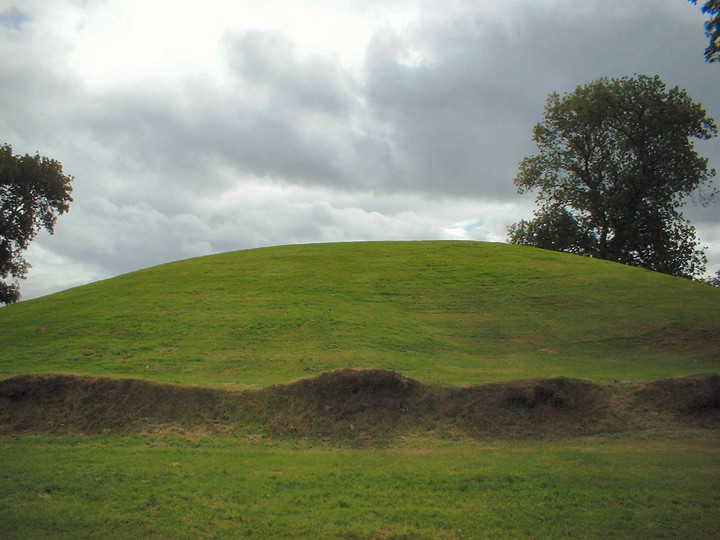
Bronze interpretation on the way from the interpretive centre to the site. I don’t know who the artist is but I like it.

Bronze interpretation on the way from the interpretive centre to the site. I don’t know who the artist is but I like it.

The main mound from the north.

North-west arc of the main mound.

The main mound, with chanting enchantress in red.

The cairn under the mound during excavation.

The mysterious, multi-period mound.

The almost flattened barrow.

The interior ditch. The exterior bank is to the left.

South-western side of the earthworks.

A wide view, not stitched but cropped from a standard photo.

Another less defined mound on the site.

Another view from the mound, I think that is a lesser mound in the centre of the frame

View from the mound

Another view of the mound

View from on top of the mound

The main mound wideview

The main mound
Perched on a hill outside Armagh city is Emain Macha – or Navan Fort.
More info :
Research teams believe they have found evidence of “absolutely huge” religious structures at Navan Fort outside Armagh city.
More info :
Easier to add the links :-)
Curse Of Macha
Story of Emain Macha
CÚ Chulainn& The Cattle Raid Of Cooley
I spotted this in ‘The Age of the Saints‘ by William Copeland Borlase (1893).
Between Armagh and the Navan Fort (the ancient Emain of the romances), beside an ancient paved track, is a famous rag-well sacred to St. Patrick. When we visited it a few years since the thorns which spread over it were literally covered with strips of cloth of all colours and of all ages, from a rotten tatter to one affixed that very day. In Ireland the idea present to the mind in offering rags seems to be that the particular disease should be left behind with the shred. Mr Windle* has preserved the following ritual words: ‘Air impide an Tiarna mo cuid teinis do fhagaint air an ait so,’ meaning ‘By the intercession of the Lord I leave my portion of illness on this place.’ The original idea of votive offerings became inseparable from the sequel that with the presentation of the sacrifice the object for which it was made was gained [sic].
*MSS. R.I. Acad. 15. Cork East and West, p. 852. Again, he says, ‘Rags are not offerings or votive. They are riddances. Thus, you have a headache: you take a shred and place it on the tree, and with it you place the headache there.’ Ibid. 16. Topography of Desmond, p. 802.
The well is indeed about half-way between Armagh and the fort, on a direct and old road. Today it’s amidst a housing estate called St Patrick’s Park and the view on Google Maps makes it look very neglected. But when the houses were built it was excavated. There’s a photo on the NISMR that shows a digger going round it- the archaeological report from the time says ‘the builders showed the utmost respect for the well and particularly its ‘fairy thorn’. It also says that it was traditionally visited on the feast of St Peter and St Paul, the 29th June. So that’s interesting, that it’s not about St Patrick himself. And so the report tentatively suggests a pre-christian connection, what with the day being close to the solstice. But who knows.
Anyway I post this in the hope that someone might like to visit it if they were at Navan Fort – they have an interpretation centre there with a roundhouse, and who can resist a real life roundhouse.
In his excellent book, The Book of the Cailleach, Stories of the Wise-Woman Healer, Gearoid O Crualaoich tells the tale of how Emain Macha got its name.
There were three kings , Dithorba, Aed Ruad and Cimbaeth who took it in seven year stints to rule over Ireland. When Aed Ruad died his daughter, Macha Mongruad demanded her fathers turn of the kingship. The remaining two kings refused to surrender the kingship to a woman, so Matha defeated them in battle and took her seven year turn.
When Dithorba died his five sons claimed the kingship. Macha fought and defeated the sons and banished them to Connaught. Then she married Cimbeath.
Matha went to visit the five sons disguised as a hag. The sons try to trick Macha with lies but one by one she ties them up and brings them back to Ulster, where she orders them to dig a ring fort as a capital for Ulster and marked out the boundaries of the fort with a pin from her golden brooch.
The fort was founded four hunderd and five years before Christ and lasted until four hundred and fifty years after Christ.
Some good information on the site







